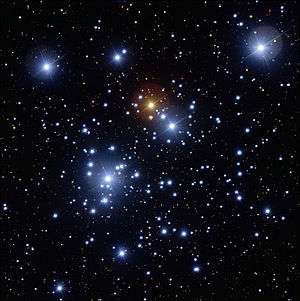HR 4887
HR 4887 (HD 111904) is a suspected variable star in the open cluster NGC 4755, which is also known as the Kappa Crucis Cluster or Jewel Box Cluster.
 NGC 4755, with HR 4887 on the right Credit: ESO/Y. Beletsky | |
| Observation data Epoch J2000 Equinox J2000 | |
|---|---|
| Constellation | Crux |
| Right ascension | 12h 53m 21.89463s[1] |
| Declination | −60° 19′ 46.5630″[1] |
| Apparent magnitude (V) | 5.77[2] |
| Characteristics | |
| Spectral type | B9 Ia[3] |
| U−B color index | −0.34[4] |
| B−V color index | +0.32[4] |
| Variable type | α Cyg?[5] |
| Astrometry | |
| Radial velocity (Rv) | −19.00[6] km/s |
| Proper motion (μ) | RA: −4.299[7] mas/yr Dec.: −1.101[7] mas/yr |
| Parallax (π) | 0.3569 ± 0.0729[7] mas |
| Distance | approx. 9,000 ly (approx. 2,800 pc) |
| Absolute magnitude (MV) | −7.00[8] |
| Details[8] | |
| Mass | 18.9 M☉ |
| Radius | 69.9 R☉ |
| Luminosity | 112,000 L☉ |
| Surface gravity (log g) | 2.02 cgs |
| Temperature | 12,680 K |
| Rotational velocity (v sin i) | 70 km/s |
| Age | 80 Myr |
| Other designations | |
| Database references | |
| SIMBAD | data |
Location
.png)
HR 4887 is one of the brightest members of the NGC 4775 open cluster, better known as the Jewel Box Cluster.[9] It forms the apex of the prominent letter "A" asterism at the centre of the cluster. The cluster is part of the larger Centaurus OB1 association and lies about 8,500 light years away.
The cluster, and HR 4887 itself, is just to the south-east of β Crucis, the lefthand star of the famous Southern Cross.
Properties
HR 4887 is a B9 bright supergiant (luminosity class Ia). It is over 100,000 times the luminosity of the sun, partly due to its higher temperature over 12,680 K, and partly to being seventy times larger than the sun. The κ Crucis cluster has a calculated age of 11.2 million years, and HR 4887 itself eight million years.[8]
In 1958, HR 4887 was reported to be at visual magnitude 6.80 and on this basis is included in the New Catalogue of Suspected Variable Stars with a range of variation of 5.70 - 6.80.[10] No other observer has measured it far from magnitude 5.75, but measurements of known variable class B stars found that HR 4887 is variable by about a tenth of a magnitude. It is thought likely to be an α Cygni-type variable.[5]
References
- van Leeuwen, F. (November 2007), "Validation of the new Hipparcos reduction", Astronomy and Astrophysics, 474 (2): 653–664, arXiv:0708.1752, Bibcode:2007A&A...474..653V, doi:10.1051/0004-6361:20078357.
- Høg, E.; Fabricius, C.; Makarov, V. V.; Urban, S.; Corbin, T.; Wycoff, G.; Bastian, U.; Schwekendiek, P.; Wicenec, A. (2000). "The Tycho-2 catalogue of the 2.5 million brightest stars". Astronomy and Astrophysics. 355: L27. Bibcode:2000A&A...355L..27H. doi:10.1888/0333750888/2862.
- Dufton, P. L.; et al. (2006), "The VLT-FLAMES survey of massive stars: Stellar parameters and rotational velocities in NGC 3293, NGC 4755 and NGC 6611", Astronomy and Astrophysics, 457: 265–280, arXiv:astro-ph/0606409, Bibcode:2006A&A...457..265D, doi:10.1051/0004-6361:20065392.
- Dachs, J.; Kaiser, D. (November 1984), "UBV photometry of the southern galactic cluster NGC 4755 = Kappa Crucis", Astronomy and Astrophysics Supplement Series, 58: 411–429, Bibcode:1984A&AS...58..411D.
- Lefever, K.; Puls, J.; Aerts, C. (2007). "Statistical properties of a sample of periodically variable B-type supergiants. Evidence for opacity-driven gravity-mode oscillations". Astronomy and Astrophysics. 463 (3): 1093–1109. arXiv:astro-ph/0611484. Bibcode:2007A&A...463.1093L. doi:10.1051/0004-6361:20066038.
- Gontcharov, G. A. (November 2006), "Pulkovo Compilation of Radial Velocities for 35 495 Hipparcos stars in a common system", Astronomy Letters, 32 (11): 759–771, arXiv:1606.08053, Bibcode:2006AstL...32..759G, doi:10.1134/S1063773706110065.
- Brown, A. G. A.; et al. (Gaia collaboration) (August 2018). "Gaia Data Release 2: Summary of the contents and survey properties". Astronomy & Astrophysics. 616. A1. arXiv:1804.09365. Bibcode:2018A&A...616A...1G. doi:10.1051/0004-6361/201833051. Gaia DR2 record for this source at VizieR.
- Aidelman, Y.; Cidale, L. S.; Zorec, J.; Arias, M. L. (2012). "Open clusters. I. Fundamental parameters of B stars in NGC 3766 and NGC 4755". Astronomy & Astrophysics. 544: A64. Bibcode:2012A&A...544A..64A. doi:10.1051/0004-6361/201219069.
- Kharchenko, N. V.; Piskunov, A. E.; Röser, S.; Schilbach, E.; Scholz, R.-D. (2004). "Astrophysical supplements to the ASCC-2.5. II. Membership probabilities in 520 Galactic open cluster sky areas". Astronomische Nachrichten. 325 (9): 740–748. Bibcode:2004AN....325..740K. doi:10.1002/asna.200410256.
- Samus, N. N.; Durlevich, O. V.; et al. (2009). "VizieR Online Data Catalog: General Catalogue of Variable Stars (Samus+ 2007-2013)". VizieR On-line Data Catalog: B/gcvs. Originally Published in: 2009yCat....102025S. 1. Bibcode:2009yCat....102025S.